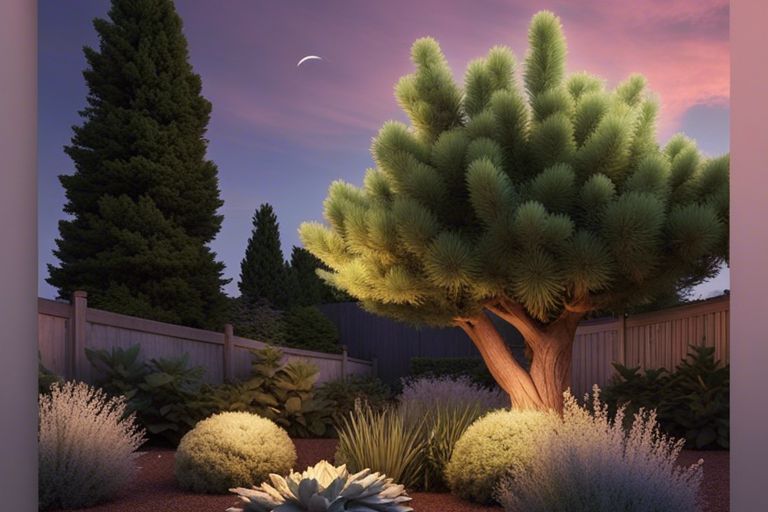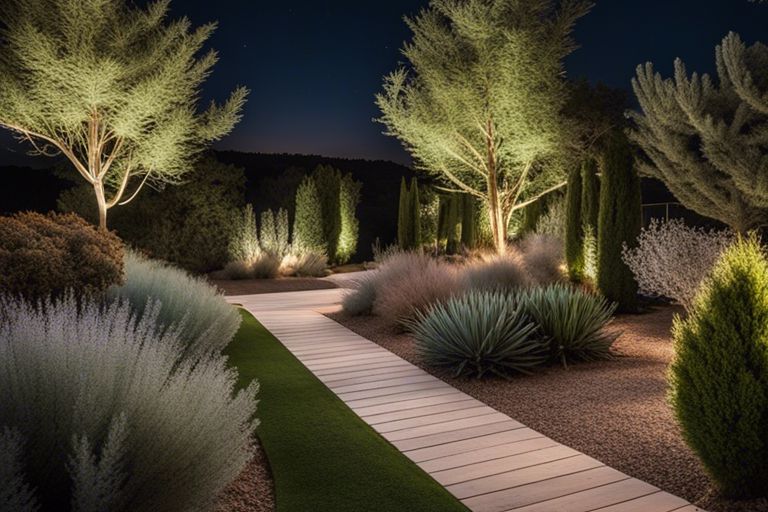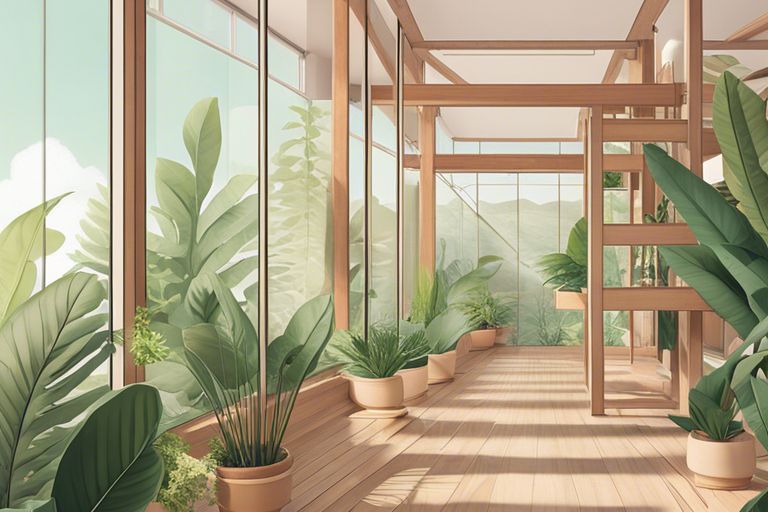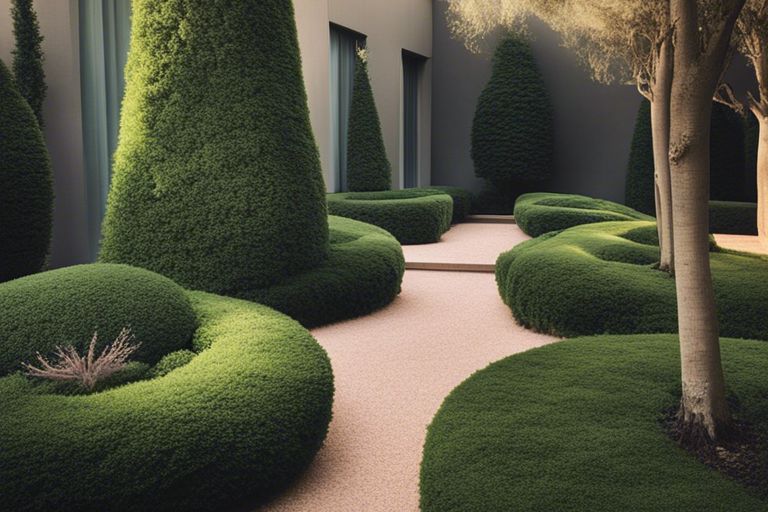Most gardeners may overlook the enchanting combination of landscape lighting and junipers, yet your outdoor space can truly transform when you blend these elements harmoniously. With their graceful shapes and vibrant colors, junipers provide a stunning backdrop for your lighting plans. In this guide, we’ll explore how to enhance your garden’s beauty while creating a warm and inviting ambiance that showcases your beloved junipers after the sun sets. Let’s explore into techniques that will not only complement but elevate your landscape’s aesthetics beautifully.

Key Takeaways:
- Contrast your junipers with varied lighting styles to enhance their natural shape and color.
- Highlight specific juniper features to create focal points in your landscape design.
- Layer your lighting to create depth and dimension in combination with the junipers’ evergreen foliage.
Choosing the Right Junipers
While landscape lighting can enhance the beauty of your garden, choosing the right junipers for this purpose is equally important. With their evergreen foliage and diverse varieties, junipers can complement your outdoor aesthetic while serving as an excellent backdrop for illumination. The goal here is to ensure that your selected junipers not only harmonize with the lighting you plan to incorporate but also create a captivating nighttime ambience that reflects your personal style.
Selecting Juniper Varieties for Landscape Lighting
Right from the outset, it’s vital to consider the specific varieties of junipers that will align well with your lighting scheme. Some junipers, such as the creeping juniper or the upright varieties like ‘Skyrocket’, lend themselves beautifully to dramatic spot lighting. This type of lighting highlights the juniper’s textures and colors, creating an enchanting visual. Additionally, low-growing junipers can serve as elegant pathways or ground covers, flattering the soft glow of LED lights and ensuring safety while adding to the aesthetic appeal of your landscape.
Considerations for Mature vs. Young Junipers
An necessary factor in your selection process involves discerning the differences between mature and young junipers. Mature junipers possess a fuller shape and established structure that lends itself beautifully to being highlighted by landscape lighting. When illuminated, they can create stunning silhouettes and shadows that infuse your garden with depth and character. Conversely, younger junipers might not deliver the same impact due to their relatively sparse foliage. However, incorporating young junipers can be part of a long-term vision, where you plan for them to grow into mature specimens, ideally complementing your landscape lighting over time.
To maximize the visual impact of your landscape lighting, consider the growing habits and full size of the junipers you choose. You’ll want to think ahead about how these plants will mature and how the lighting will enhance their features as they grow. Placement is key—make sure to select lighting thatwon’t hinder their growth and that the light sources are positioned to showcase their unique forms. Recall, your ultimate aim is to create a seamless integration of junipers and lighting that enhances the beauty of your garden, both day and night.
Assessing Your Outdoor Space
One of the first steps in integrating aesthetically pleasing landscape lighting with junipers is to assess your outdoor space. This foundational assessment will not only guide you in selecting the appropriate lighting fixtures but also help you create a harmonious blend of natural beauty and illumination. Start by considering the size and layout of your garden, as well as how the junipers fit into the overall design. Understanding the growth patterns and care requirements of junipers can be extremely beneficial; for more insights on this, you can check out Landscaping with Juniper: Maintain and Prune This Hearty ….
Evaluating Natural Light and Shade Patterns
For a successful outdoor lighting scheme, it’s important to evaluate the natural light and shade patterns in your space. Take note of where sunlight falls throughout the day and how it interacts with your junipers. This will aid you in deciding on the right times to add illumination, as well as determining whether you might want softer lights that complement filtered sunlight or brighter fixtures to bring out the vivid hues of your junipers in the evening. Understanding these dynamics will help you avoid overly bright areas that may wash out the natural greenery.
Identifying Focal Points and Visual Interest
With your outdoor space mapped out in terms of light and shade, it’s time to identify focal points and enhance the visual interest of your landscape. Consider where the junipers are located and how they can frame or complement certain features, such as a garden path, a seating area, or a decorative statue. Proper placement of your lighting can accentuate these points, drawing the eye and creating a welcoming ambiance as darkness descends.
Interest in lighting is not merely about the junipers’ placement but rather how you can create layers of light to enhance the scene. For instance, downlighting can create a soft glow that highlights your junipers’ lush foliage while casting gentle shadows that add depth and intrigue. By strategically choosing and positioning your lights, you ensure that your landscape becomes a true nighttime haven, inviting curiosity and enchantment into your garden space while promoting the natural beauty of your junipers.
Selecting Landscape Lighting Options
Keep in mind that the right lighting can transform your garden into a magical haven, especially when combined with the textures and colors of your junipers. As you venture into creating a harmonious environment, it’s necessary to explore the various lighting options available. An ideal balance between function and aesthetics is key to showcasing not only the architectural elements of your garden but also the enchanting qualities of the junipers.
Types of Lighting Fixtures: Solar, Low-Voltage, and Line-Voltage
Lighting options can vary significantly in terms of energy consumption and effectiveness. Here are some of the most popular choices:
| Type | Description |
| Solar | Solar lights are eco-friendly and easy to install. They absorb sunlight during the day and illuminate your garden at night. |
| Low-Voltage | These fixtures use less power, making them energy-efficient. They provide a softer glow that beautifully highlights your junipers. |
| Line-Voltage | Generally brighter, line-voltage lighting is suitable for larger areas but requires professional installation due to higher wattage. |
| LED | LED lights are energy-efficient and long-lasting, available in various colors and intensities to enhance your landscape. |
| Smart Lighting | Smart systems allow you to control brightness and color through apps. They offer flexibility depending on the occasion. |
Any choice you make should complement the natural form of your junipers while contributing to the overall ambiance of your landscape.
Color Temperature and Lumen Output Considerations
With the vast array of lights available, it’s important to consider both color temperature and lumen output to ensure you create the desired atmosphere in your garden. Color temperature, measured in Kelvin (K), can significantly affect the mood of your space. For example, warmer tones (around 2700K-3000K) create a cozy feeling, perfect for intimate gatherings, while cooler tones (over 4000K) evoke a more contemporary or vibrant ambiance.
| Attribute | Details |
| Color Temperature | Choose between warm white, cool white, and daylight to achieve different visual effects. |
| Lumen Output | Higher lumens mean brighter light; consider how much illumination your junipers will need without overwhelming them. |
| Light Placement | Strategically place lights to cast shadows and highlight the unique shapes of your plants. |
| Layering | Utilize different types of lighting to create depth and visual interest in your landscape. |
| Trends | Stay updated on lighting trends to keep your landscape aesthetically engaging. |
Temperature plays a vital role in enhancing the beauty of your junipers. Warmer temperatures will provide a welcoming glow, making your garden feel inviting, while cooler temperatures can create a stunning contrast against the greenery. Aim for a balanced lumen output to illuminate your junipers without overpowering them; a softer light often works in harmony with the foliage. Ensure you consider your lighting plan carefully, as it can truly elevate your garden experience.
| Aspect | Importance |
| Warm light | Enhances the natural beauty of plants, creating a soft atmosphere. |
| Cool light | Creates a modern, sleek look; can emphasize features like stone paths or sculptures. |
| Lumen brightness | Directly affects how you perceive your landscape at night. |
| Color consistency | Aids in creating an overall cohesive look and feel. |
| Light directionality | Can affect how your junipers are perceived; play with different angles for artistic effects. |
Designing a Cohesive Look
Once again, the art of landscape lighting allows you to transform the spaces around your home, turning the ordinary into the extraordinary. In particular, integrating landscape lighting with junipers can create a seamless aesthetic that ties your garden elements together beautifully. To achieve a harmonious look, consider how you can balance the placement of light sources to highlight the natural beauty of your junipers while ensuring that the overall design resonates with the architectural features of your home. Mixing various types of lighting, from subtle path lights to more pronounced spotlights, can establish a sense of unity throughout your garden.
Balancing Light and Shadow for Visual Appeal
With thoughtful placement of your lights, you can harness the enchanting interplay of light and shadow. Use uplighting strategically around your junipers to create towering displays that enhance their graceful forms in the evening glow. Conversely, installing low-level downlighting can wash the ground with soft illumination, allowing the unique foliage of your junipers to cast gentle shadows that evoke a tranquil atmosphere. This balance not only draws attention to the lushness of your greens but also keeps your outdoor space feeling intimate, serene, and inviting.
Creating a Focal Point with Uplighting or Downlighting
With the right approach, uplighting can turn your junipers into stunning focal points in your landscape design. By illuminating the verdant hues and intricate textures of the foliage, uplighting creates a dramatic effect, accentuating the curves and angles of the junipers. Conversely, if you choose downlighting, you can create a more subdued ambiance that highlights a specific area in your garden, inviting guests to explore the space while also providing a soft glow that enhances the intimacy of your outdoor gatherings.
Point to consider, when implementing your uplighting or downlighting, is to ensure that the fixtures are positioned thoughtfully. Experiment with angles and heights to find the perfect balance that brings out the rich colors and textures of the junipers while avoiding harsh glares or overly bright spots. Properly placed lights can add drama to the silhouette of the plants, drawing the eye upward and enveloping the space in warm, inviting light. A focused lighting plan can not only enhance the beauty of your junipers but also create an enchanting atmosphere that beckons you to enjoy your garden long into the evening hours.
Installation and Maintenance Tips
Your journey toward integrating aesthetically pleasing landscape lighting with junipers is not merely about vision, but also about sensible practices that ensure lasting beauty and functionality. To achieve this, pay attention to both installation and maintenance strategies, which can profoundly impact your overall success. Here’s a helpful checklist to consider:
- Choose the right fixtures: Opt for fixtures that complement the natural colors and textures of your junipers.
- Plan your layout: Sketch a lighting plan that highlights the unique shapes and textures of your plants.
- Positioning: Place lights at strategic angles to create depth and drama.
- Use low-voltage systems: They are safer, more energy-efficient, and easier to install.
- Consider smart technology: Incorporate timers or smart home systems for added convenience.
Assume that your landscape is one of your most treasured spaces, and treat it as such by employing sustainable and effective methods in your installation.
Safe and Efficient Installation Practices
Efficient installation begins with a clear vision. While you might be tempted to dive in right away, it’s vital to take your time and plan each step thoroughly. Always begin by marking where you intend to place your lights. You want to ensure the junipers are well illuminated without overwhelming their graceful presence. Digging shallow trenches for wiring can minimize the disturbance to your garden, and using a low-voltage system not only reduces risk but also saves on energy costs.
Always take into consideration the natural environment of your landscape features, ensuring that each fixture complements and enhances their beauty. Keeping your junipers intact and healthy is of utmost importance, which means avoiding damage when installing your lights. Use flexible conduits to safeguard wiring from foliage and keep the aesthetic pleasing and unbroken.
Regular Maintenance for Optimal Performance
On a practical note, regular maintenance is important to keep your lighting system functioning at its best. Without proper care, even the most beautiful installations can fall prey to wear and tear, leading to diminished illumination and safety hazards. Regularly check connections for moisture and dirt, ensuring that any debris does not obstruct the light from your junipers and other landscaping features.
Plus, consider performing a seasonal check-up to clean your fixtures, adjust their positions, and inspect for any weather-related damage. Pay particular attention to the brightness of your lights, as fallen leaves or snow can diminish their glow. By being proactive, you enhance not only the aesthetic appeal but also ensure that the lighting system operates safely and efficiently over time. Regular updates or bulb replacements when needed can ensure that your lights shine brightly, illuminating your cherished junipers and creating a welcoming ambiance.
Integrating Junipers with Hardscapes and Water Features
For anyone looking to elevate their outdoor spaces, intertwining the lush beauty of junipers with hardscapes and water features can create a stunning visual harmony. Hardscapes, such as patios, walkways, and walls, offer structural elements that can significantly enhance the aesthetic appeal of your garden. When you pair these with the gentle cascading forms of junipers, you generate a feeling of unity and tranquility in your landscape. By considering the colors and textures of both elements, you can craft a serene outdoor retreat that invites relaxation and contemplation.
Combining Junipers with Patios, Walkways, and Walls
Patios are an excellent opportunity to incorporate junipers as they provide a versatile backdrop for these hardy shrubs. Think about lining the edges of your patio with dwarf junipers, which can frame your space beautifully and add a sophisticated touch. Their naturally low and spread-out growth habit can also function as a soft divider, giving your patio a cozy, intimate feel. Furthermore, junipers’ adaptability to various soil conditions and their low maintenance requirements make them an ideal choice. A bit of planning will allow your outdoor area to flow seamlessly between the hardscape and greenery, creating delightful transitions that are pleasing to the eye.
Walkways can benefit from the addition of junipers as well. By placing these plants along the sides of a pathway, you create a sense of continuity that leads the eye forward. Consider using larger varieties of junipers for added visual impact as you meander through your garden. The soft needle-like foliage brings a texture that contrasts beautifully against the hard surfaces of your walkways. You could also incorporate different species of junipers to introduce variety and maintain interest throughout the seasons.
Incorporating Junipers into Pond or Fountain Designs
Combining junipers with ponds or fountains can offer a delightful interplay between water elements and greenery. These shrubs thrive near water features as they appreciate slightly moist soil while preventing erosion around the water’s edge. Placing junipers strategically around your pond or fountain can create an enchanting atmosphere, allowing the beauty of flowing water to complement the lush, evergreen foliage of the junipers. This design choice not only enhances the stunning visual composition but also encourages wildlife to visit, adding a dynamic quality to your serene space.
For instance, consider planting low-growing junipers that spill delightfully over rocks and into the water, creating a natural and inviting look. In doing so, you’re not only beautifying your outdoor space but also establishing a habitat for local birds and beneficial insects. Keep in mind how the colors of the junipers complement the reflections on the water—a rich mixture of varying shades can truly make your garden a place of enchantment. With a bit of thought, your junipers can create a magical setting where both hardscapes and water features coexist beautifully.
To wrap up
Considering all points, integrating aesthetically pleasing landscape lighting with junipers offers an enchanting way to showcase your garden’s natural beauty while creating a warm and inviting atmosphere. As you explore different lighting options, envision how soft, subtle illumination can highlight the textured foliage of your junipers, drawing attention to their unique shapes and colors, especially as the sun dips below the horizon. When placed strategically, your lights can create a stunning interplay of light and shadow, turning your garden into a captivating retreat where you can unwind and connect with nature.
Ultimately, embracing this harmonious blend of landscape lighting and junipers allows you to transform your outdoor space into a magical setting that invites evenings spent outdoors. Remember to experiment with different styles, whether you choose understated path lights, whimsical string lights, or elegant uplighting, making sure that your choices reflect your personal aesthetic. With a touch of creativity and care, your garden can become not just a collection of plants, but a symphony of light and life that you and your guests will surely enjoy for years to come.
FAQ
Q: What are the best types of landscape lighting to use with junipers?
A: The best types of landscape lighting to use with junipers include LED spotlights, path lights, and uplights. LED spotlights can provide focused illumination that highlights the texture and color of junipers. Path lights can line walkways and enhance safety while complementing the natural beauty of the junipers. Uplights are particularly effective for showcasing the vertical structure of junipers, creating dramatic shadows and visual interest in the landscape.
Q: How can I ensure that the lighting does not harm the junipers?
A: To protect the junipers while integrating lighting, it’s important to choose low-wattage LED fixtures that produce minimal heat. Position lights to avoid direct contact with the plants and maintain adequate distance—generally at least 12 inches away from the foliage. Additionally, ensure that the fixtures are properly shielded to prevent light pollution and glare, which can disrupt the natural growth patterns of junipers.
Q: Can I use different colors of landscape lighting to enhance my junipers?
A: Yes, different colors of landscape lighting can be used creatively to enhance the aesthetic appeal of junipers. Soft warm white or cool blue lights can create a calming ambience, while colored lights, such as greens or purples, can add a unique flair to your landscape design. However, it’s imperative to test colors in the evening before installation, as lighting colors can appear differently at night. Ensure that the chosen colors complement the natural hues of the junipers to maintain a harmonious landscape.



